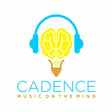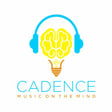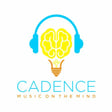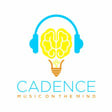Become a Creator today!Start creating today - Share your story with the world!
Start for free
00:00:00
00:00:01

Episode 07: Feeling the Beat
How do our brains tell where the pulse is in music? Can we improve our sense of rhythm or is it something we're just born with? In this episode, we learn how professional percussionist Jack Van Geem became a precision timing machine, and how he teaches his student, Katrina Shore, to develop her skills. We also talk to music cognition researcher Jessica Grahn to find out what's happening in our brains when we feel the beat.
Transcript
00:00:02
Speaker
Welcome
Introduction and Sean Carroll's Quote
00:00:03
Speaker
back to Cadence, the podcast where we explore what music tells us about the mind. I'm Andrea Viscontes. Last time, we ended the episode with a quote from physicist Sean Carroll, who speculated that one of the reasons we love music has to do with our relationship with time.
00:00:19
Speaker
How
Measuring Time and Biological Rhythms
00:00:19
Speaker
do you measure time? Well, we look at a clock. So what is a clock? A clock is something that does the same thing over and over again in a repetitive way, predictably, compared to other clocks that are also doing the same thing over and over again. And we have a feeling inside our bodies for the passage of time
00:00:37
Speaker
Because, in part, we are full of clocks. You know, we have our breathing, we have our heartbeats, we have the neural impulses rushing around our nervous system and so forth. We have things that happen over and over again. We
Biological Rhythm and Music
00:00:50
Speaker
have a natural sense of rhythm, if you like.
00:00:53
Speaker
And I think that, you know, it is the least surprising thing in the world to think that this kind of rhythmic but not perfectly predictable kinds of patterns you find in music have a natural resonance with us as biological or physical creatures, because, you know, there's these things that the most primitive kind of music is just rhythmic, right? It's just like, and then you add on to that and make it more complicated.
00:01:17
Speaker
Of course that resonates with us at a fundamental level. As
Training the Musical Brain
00:01:21
Speaker
someone who thinks about the nature of time, that makes absolute sense to me.
00:01:35
Speaker
So is Sean on to something? In this episode, we'll find out. At the San Francisco Conservatory of Music, I teach a course called Training the Musical Brain. And in it, I try to use neuroscience to help musicians develop more effective practice strategies. And
Precision in Percussion
00:01:49
Speaker
some students get really into it. Over the years, I found that percussionists in particular are especially likely to respond well to an evidence-based approach.
00:01:58
Speaker
Maybe it's because time is in some ways more measurable, more precise, than many other aspects of musicality. You can either be in time or out of time, and you can see whether or not you're in time by measuring it. Or maybe there's something about percussionists that's different altogether. And what I found is that if they're students of Jack Van Geem, they really are a special breed.
00:02:22
Speaker
I'm Jack Van Geem. I played with the symphony for 32 years as principal. I've been playing marimba since I was four years old.
00:02:30
Speaker
Jack Van Geem recently retired from his position as principal percussionist at the San Francisco Symphony. Before
Katrina Schor's Journey in Percussion
00:02:37
Speaker
his retirement, he'd been playing with that orchestra since 1981. As you might expect, he's incredibly precise, both as a player and as a teacher. And also, he has the best posture I've ever seen on a human being. One of his students who took my class a while back is in many ways his perfect protege, including emulating his perfect posture.
00:02:58
Speaker
My name is Katrina Schor. I'm a percussionist at the San Francisco Conservatory of Music studying with Jack Van Geem. About a year ago, Katrina asked me if she could do an independent study project with me, and I couldn't have been more delighted. She's the kind of student that professors' dreams are made of. She's interesting, she's reliable, she's thoughtful, and she has a very respectable collection of witty retorts.
00:03:22
Speaker
So we embarked on a study together under the guise of understanding how musicians develop a sense of pulse. But really, both of us wanted to get into Jack's head. Jack is probably my favorite person in the whole world. Jack is an amazing player, but he's also a very critical thinker and has studied how to teach, has studied himself and how he learns and how he thinks.
00:03:51
Speaker
He's able to listen or look at a student or get to know a student and figure out what it is that, for one, makes them tick. He's figured out how to help people in ways that I don't know if many people can.
00:04:16
Speaker
I've always thought that percussionists are a little bit like unicorns. There's something magical about how they're able to do what they do. I mean, imagine sitting on stage for many, many minutes, waiting for your part to come. And
The Marimba's Role and History
00:04:31
Speaker
essentially you have on your music stand a sheet of music that says, like, 68 bars of rest, and then an incredibly precise snare drum passage.
00:04:40
Speaker
and you have to get it perfectly timed because if you don't, everyone will notice and the whole piece could fall apart. So on the one hand, they're not always involved in every aspect of a musical piece, but on the other hand, they're absolutely critical and they can make or break it. Like Rian Sheehan, Katrina came to percussion almost by accident.
00:04:59
Speaker
Well I used to play clarinet and then piano and then I had a teacher who for some reason took interest in me and asked me to join a percussion ensemble in junior high and I did it and thought it was fun so I just kept doing it. I always wondered how symphony percussionists
00:05:17
Speaker
can become so proficient on so many different instruments. I mean, you've got the timpani and the dry ankle and the marimba and not just, you know, one set of drums. There are lots and lots of different types of percussionists just because there's lots and lots of different types of percussion. Generally, as a younger college student, you can't specialize in which instrument. You have to learn
00:05:39
Speaker
a lot of them or all of them. But now that I'm in grad school, they have let me specialize in marimba. A marimba? Anyone know what that even is?
00:05:56
Speaker
marimba is an instrument it kind of looks like a xylophone a very big xylophone a five octave eight foot xylophone that isn't actually a xylophone it's actually one of the oldest instruments in the world its origin is in africa actually and in south america
00:06:19
Speaker
and now it's becoming more instrument that has a role similar to guitar in that it's not super loud but you can collaborate with other instruments.
Percussionist Lifestyle
00:06:30
Speaker
The path forward isn't very clear for marimba players right now in part just because no one really knows what it is outside of the music world.
00:06:41
Speaker
I ask Katrina if she owns a marimba or if she has to go somewhere to practice on one since the instrument is huge and she lives in San Francisco where rents are ridiculous. I do.
00:06:51
Speaker
It's in my bedroom. It's bigger than my bed. See? Percussionists, a strange breed.
Jack Van Geem's Philosophy
00:06:57
Speaker
So the quest of finding out what goes on in their brains was one I couldn't wait to go on, especially if it involved the brain of a specimen as close to perfection as Jack Van Geem, and with a guide as cool and keen as Katrina. He's an amazing player. He has unique technique, self-taught.
00:07:14
Speaker
He's a tall person, has long arms, so he's developed a way of playing that is a bit unusual. Nowadays he doesn't move his body from side to side, at least on the floor, nearly as much as people, most people actually, but he has a very fluid relaxed motion with his upper body and his hands and everything is just
00:07:39
Speaker
easy looking, but he's also able to translate that into how he is able to create music itself. It's just, it's seamless and he has musicality that is pretty unparalleled, especially for percussionists.
00:08:24
Speaker
Hi, Jack. Good morning, Katrina. How are you? I'm good. How are you? Good. Oh, also, can you say your name? Oh. Full name, so that we can use that as a show. Middle name. Oh, Jack. William. Than. Game.
Internalizing Rhythm
00:08:38
Speaker
Or just your first time. Oh, is that what you want?
00:08:42
Speaker
I'm Jack Van Geem. I played with the symphony for 32 years as principal. I've been playing marimba since I was four years old and trying to make things in wood. In other words, I've been hammering my whole life, whether it was percussion or wood. What, you might be thinking, is the relationship between hammering and keeping time.
00:09:02
Speaker
I think some of my concept of how I play and conceive of time is related to both of those activities, believe it or not. The hammering was an activity that had a goal of just putting a nail on a board, but there's a consistency to it that has nothing to do with all the refinements that we do with rhythms and notes. It's just a simple, repetitive act.
00:09:28
Speaker
What I did on the marimba was then to play scales in time, to play rhythms in time, and at some point it helped me to understand the best way to play in time is to not use your hands and the complexity that it's involved with to create time, but to use your hands to fill the time that your brain supplies to it. In other words, that hammer that I was using as a four-year-old has become what I refer to as my bass drummer in the back of my head who pounds away in whatever time I want to play.
00:09:57
Speaker
and allows me then to fill that time with my hands. It's a subtle difference, but it's a big difference. If you are using your hands to create the sense of time, when your hands are busy, time will seem to occur at a different rate than if your hands are not busy.
00:10:18
Speaker
And like Katrina and Rian, Jack also came to choose his instrument because of something related to his childhood environment.
Childhood Rhythmic Influences
00:10:25
Speaker
Parents, this seems to be a trend, so fair warning. Be mindful of what you expose those little ears to.
00:10:31
Speaker
I started playing at the age of four because I just loved music. It was anything with strong pulse rhythm, but also strong harmonies. And my mom loved South American dance music, and she played a lot of that. And that provides both of those. Tangos are this strong rhythm, which interestingly is not a typical bass drum rhythm. It's a one, two, three, one, two, three, one, two, one, two, three, one, two, three, one, two.
00:11:01
Speaker
At age four, I would play clave in the little band that I played in. It was a marimba band. And so I learned with a funny mnemonic shave, haircut, six bits, shave, haircut. It didn't make any sense to me. I didn't shave. I didn't know anything about what a bit was. But anyway, that's how I learned it.
00:11:19
Speaker
And the fact that I loved these strong rhythms, I would even hug the stereo at home, but I would rock with it as these rhythms were going. So all of that was really developing this sense of a core pulse or a core rhythm.
00:11:37
Speaker
And if you're hugging a speaker, you're not using your hands to do anything except hang on to the speaker. And I actually pulled it over on me once. It was this big thing and I probably wouldn't be here today, but there was a couch that caught it and I still remember what happened. My parents coming in and rushing to lift this thing off of me.
00:11:52
Speaker
When Katrina first approached me about trying to figure out how Jack keeps time, she described this notion of him having a bass drummer in the back of his head, which is what he actually calls it. It's not just a function of tapping feet. It's a separate little slave system that tells him where the pulse is. We'll get back to this idea of what I mean by slave system, but let's listen to how Jack explains it.
00:12:16
Speaker
The bass drummer is that part of your brain that responds to dance and makes you move. And if you think about it, when you move to dance, you are directing your hands and your legs to move to that time. You're not letting your hands and your legs go backwards and tell your brain where that pulse is.
00:12:35
Speaker
And so that's where I start developing this idea that I'm gonna direct my hands what to do, not the other way around. Just because they're doing these complex little things with notes and rhythms, it shouldn't be any different than when I direct them what to do if I dance.
00:12:52
Speaker
Once you have the bass drummer established, the concept of the bass drummer, and I have to say whenever I demonstrate this, I use a sound that was introduced to me by my girlfriend at the time, eventually a fiance, and now my wife of 45 years, which she called the pets, which is if I said something she didn't like, she'd slap the back of my head, and this sound, which doesn't hurt, is sort of how I demonstrate. So that's my bass drummer. It's just this thing going,
00:13:20
Speaker
You can cut all that out if you want. Once you have the bass drummer
Visualizing Rhythm
00:13:23
Speaker
in place, we'll say...
00:13:27
Speaker
Then it's a matter of teaching the hands to play within that, to use that bass drummer's reference. And I think of each of the beats in the sequence as a box that, depending on what the meter is, is subdivided, pre-subdivided for me to show me how many slots within that beat I can fill.
00:13:56
Speaker
Okay, for example, let's say we're in 6-8. And I'm going to think of 6-8 and 2. So that would be the bass drum is going to make a sound on 1 and 4. And we can see a box with three openings in it for 1 and 1 of
00:14:11
Speaker
three openings for four. So we've got one, two, three, one, two, three, one, two, three, one, two, three. Now at this point it doesn't even matter that it's one and four because every box is a new box, however it appears, right?
00:14:28
Speaker
So that's a simple box, but let's say we have 16th notes. Okay, now we're going to subdivide these boxes into six. So now we've got one, two, three, four, five, six, one, two, three, four, five, six, one, two, three, four, five, six. Okay, so now when I direct my hands, all I have to do is direct them in how to fill this box. They look at a rhythm that might be one, two, and three. I'm looking at the box, feeling the box,
00:14:55
Speaker
imagining the box and I might play right, right, left, right. I'm using my hands to sort of organize how I'm going to fill that box. So in general, you know, there's a box size for everything that you're going to play. And the more you rely on the box, the less you rely on trying to count and use that as a means of
00:15:15
Speaker
as an abstraction almost of what that rhythm is, I've actually got a physical analogy that immediately has a physical feedback on what that rhythm is. It's not some abstraction, it's an actual realizable, tangible kind of event.
00:15:36
Speaker
This truly is really different from how, up until now, I've conceptualized pulse. Though
Music Cognition and Perception
00:15:42
Speaker
it does make a lot of sense and I can't wait to try it in my own music making. The bass drummer is better than using your foot or some other physical manifestation because if your foot gets off the pulse, you lose it. You don't know where you are anymore. But the idea behind the bass drummer is that the pulse is always there and you can then gauge whether your foot is tapping in the right spot.
00:16:03
Speaker
It can become the canary in the mind, too, because there are moments when you're reading through something and suddenly you're not absolutely sure where that bass drum is supposed to fit and what you look at. In other words, you don't know where the next box is. And that is a good thing to have because it's a diagnostic and you know you need to look at that measure.
00:16:25
Speaker
So Jack seems to conceive of pulse in a fundamentally different way, but there are definitely some recognizable aspects of it, like it's related to how we move. This made me wonder what happens in our brains, whether we're musicians or not, when we're moving or grooving to music or when we can feel the pulse.
00:16:41
Speaker
Because after all, there's a lot of evidence that in fact, movement is maybe one of the ways in which music started and got us going. In a previous episode, we talked about potentially that ensemble nature of music, where if one person wants you to move in sync with them, they just give you a beat. One, two,
00:17:01
Speaker
Three, go. So I contacted music cognition researcher Jessica Grohn at the University of Western Ontario in Canada because she has a great face. She's pointed out that we don't see the rhythm, we feel the beat. So I first asked her whether musicians and non-musicians experience pulse in fundamentally different ways.
00:17:21
Speaker
Interestingly, people without musical training often process time and music very similarly to those who have a lot of musical training. And that's because a major part of our musical exposure and how we learn to understand music just comes from passive listening, singing along, the normal engagement that pretty much anybody in any culture does.
00:17:42
Speaker
So everybody seems to very quickly become sensitive to the structures by those temporal structures, things like feeling the beat or feeling that this sounds a bit more like a waltz or a march. People become sensitive to that pretty early on without any sort of specific training.
00:18:01
Speaker
So
Teaching Rhythm and Timekeeping
00:18:01
Speaker
how do we internalize rhythm? By the way, Jessica will use the term beat, which is synonymous in this case with pulse, though of course musicians consider them slightly different. Musicians group beats into a measure. So we have a meter, say it's 4-4, you know that for every measure there are going to be four beats.
00:18:19
Speaker
But pulse is the underlying pulse. So if you go from one measure that's 4-4 to another measure that's 3-4, you could still have the same pulse. But of course the number of beats or the beat that you're on will be different. One of the most interesting things I think that is a response people have to rhythm is to move along to it.
00:18:39
Speaker
And one of the cool things is we can move along to a rhythm in a piece of music that we have never heard before. So the latest single comes out and we have no problem immediately starting to tap our toes or dance up and down. And the reason for that is that we're not moving to the specific rhythm because the rhythm itself tends to change from piece to piece. And all I mean by rhythm is just the pattern of time of note onsets, so beginnings of notes.
00:19:05
Speaker
in a melody. So one iconic rhythm is the William Tell. People can recognize that quite quickly. When we're moving along to music, we don't tend to tap out the whole rhythm. We can, but we don't tend to. What we tend to do is actually tap along to the steady beat that we can feel underlying that rhythm. So something like the William Tell, I'll snap along.
00:19:32
Speaker
And because of that, we don't actually have to be familiar with the rhythm itself. We just have to find that beat. And interestingly, the response that people tend to have when they can perceive a beat in music is to move along. And you see this emerge incredibly early in development. Even infants who don't really dance in synchrony will often start to move their arms and legs when they hear music that's got a nice rhythm.
00:19:59
Speaker
Katrina's trying to learn how to set and keep a beat or a pulse as accurately as Jack can. So I wondered what makes it harder or easier to feel the beat. So first I asked the percussionists, how do you teach a student to build up a bass drummer in their brain? Most students at some point have some difficulty with
00:20:20
Speaker
so-called perfect time, playing rhythms perfectly within the space they have, and there are many reasons that that occurs. But usually it is because whatever complexity they're dealing with is obscuring the way they need to keep time, getting back to the bass drummer. Their hands get busy, they lose track of exactly where that next beat is, and they let their hands go forward, assuming that everything's fine.
00:20:50
Speaker
So, in the basic case, it's a matter of separating these two things, separating how you keep time from how you then use that time to play rhythms. And a lot of it is just making them understand they can't use their foot to keep time, because their foot's going to follow what their hands are telling it to do, that they have to feel something else.
00:21:13
Speaker
One of the things that I've used that's been helpful is to try and get that memory sense of movement to become the pulse. And if you think about walking, generally, unless you've got some impairment, you walk at a fairly regular pace, right to left. And even if there's a limp, it's a consistency. So the right foot is like right, left, right, left, right. So we can use the right foot for that.
00:21:39
Speaker
Now, if you're practicing snare drum, unless you want to put a sling on and walk around a room, you're not going to be able to do that. But I generally have them transfer all their weight from one foot to the other in the time that they're trying to play. And I say transfer all the weight because as soon as you've transferred all the weight, you can't lunge to the other side because you can't say, I'm done with the rhythm. What's next?
00:21:58
Speaker
you start to become aware of things that occur at all levels of performance ability where the complexity of the rhythm is having your hands do something that doesn't accord with time. So in other words, if you're transferring all your weight and you play all your 16th notes, let's say here's our pulse and your 16th notes go
00:22:22
Speaker
You've got this big space between the last 16th note and the next beat. Well, if you're just using your foot, you might go...
00:22:37
Speaker
Right. And just adjust to it. But if you're transferring your weight, you can't. So that's a big moment when people start to do that. And then you withdraw them from any complexities that they were trying to do that they're not intellectually equipped for yet.
Metronome Limitations
00:22:52
Speaker
And sometimes go way back to where they're only playing quarters, eights and sixteenths. And then when they really start to get it, then you add triplets and then you work your way back up to where they thought they were to begin with.
00:23:04
Speaker
So what about after that? Say someone has really good time if they're transferring weight from one foot to the other. How do you get them to take that out and still have this sense of a bass drummer hitting them in the back of their head? Different ways to go about it. I've used in studio class the idea that somebody brings in a pop tune that they really respond to that's at a tempo that they want to practice an excerpt, right? And you put that on.
00:23:32
Speaker
Well, you like it because it makes you move. There's something very corporeal about your response to that, just like me as a four-year-old hugging the speaker and shaking it. And then you can start to talk about, okay, that thing that you feel when that music plays, it makes you want to dance. You feel it whether you move or not. When that music goes, and let's say you're sitting in a doctor's office and everybody's watching you, you don't want to move, but you've got your little earbuds on,
00:23:58
Speaker
There's something that makes you kind of adjust, yeah, the I twitch, I like that. There's something that makes you kind of want to move to that. I see people when I'm commuting all the time or all of a sudden the hands go up in the air and you know they're probably listening to gospel or something. Well, that response,
00:24:14
Speaker
doesn't go away because we don't act on it, it's there. And that's the source of the bass drummer. So when people start to understand this connection to that urge to move, and that becomes the pulse point, then you can start to do a lot of really good things. The other thing that's interesting to that though is that people rely on metronomes a lot to try and teach themselves good rhythm.
00:24:42
Speaker
But it's never going to teach you if you don't internalize that that click and it can do a lot of damage too because We have metronomes now that will subdivide a beat into all manner of complicated things and so what it's giving is a digital Rendition of perfection, okay
00:25:07
Speaker
And that's what we're trying to do. But the more information that you get in a short period of time, the less able you are to be perfect. You can be close, but you can't be certain every time you hit a really fast 16th note that you're absolutely with the metronome necessarily.
00:25:26
Speaker
And so people learn to just kind of be close. They stay with it. They hear themselves, get a little ahead, they back away. They get a little behind, they speed up. When you take the metronome away, that's the way they play it, for real. They slow down, they speed up. And then they'll say things like, you know, say, you're rushing here. Oh, I know, because I usually drag.
00:25:48
Speaker
Okay, but now you're rushing, which leads to another thing. You can never fix something with a negative thought because you never know when to stop doing it. So if you're saying, I need to rush because I'm dragging, you'll never know when you've rushed enough. So the way to fix it is you say, no, I need a better time. I'm dragging here. Okay, I need to be better aware of where the pulse is.
00:26:10
Speaker
So
Brain Processing of Rhythm
00:26:11
Speaker
getting back to the metronome, that means taking all these intermediary beeps and blips out and going back to the biggest beat you can. So if you're playing in 4-4, if you're having trouble getting through the whole measure accurately, play 1-3.
00:26:25
Speaker
then just try and do one. And then if you really want to test, see if you can go one, skip the next one, and then the next one. And it gets back to that thing that the true virtuosity is in the longest period of time that you can feel accurately. Then I asked Jessica about how people find the beat in music, even if they're not musicians.
00:26:48
Speaker
Yeah, all sorts of things can really influence our ability to both hear where the beat is and then also be able to synchronize to it. So one aspect of beat perception that we know is important is the type of information in the music that you're cued into to feel the beat.
00:27:04
Speaker
If you're just having a series of tones and there's no melody and harmony, no drums, no bass, even then people are pretty good at feeling a beat. So if I give you beat, beat, beat, beat, beat, beat, beat, even by the end of that, most people can start tapping along to where they think the beat is.
00:27:23
Speaker
But in music we have a lot of redundant cues. So we tend to feel the beat in the lower registers. Things like the bass or the drums and pop music really emphasize the beat for us. And then also important melodic or harmonic things tend to happen on the beat. And that gives us additional melody cues to where we should feel the beat.
00:27:43
Speaker
One thing that can really start to obscure that beat is you create what we call accents or notes that feel strong or somehow more salient off the beat. And in fact, that's actually what we often prefer in music as some degree of these
00:27:58
Speaker
accented off beats or syncopation. We don't really prefer to listen to a steady metronome even though that would give us a perfect beat. We prefer things that are a little bit more interesting and have some interplay. And one idea behind that is that that forces you as the listener to internalize that beat in order to help keep track of it. And so you might even if you're not actually moving be tapping along in your head in order to stay in sync with the music.
00:28:25
Speaker
And so what you can do is the more offbeats and accents that you put on these offbeats in a piece of music, the harder and harder it becomes to feel that intrinsic beat. Can we actually see some part of the brain tracking a pulse? If, for example, we put Jack in the scanner, what would his bass drummer look like?
00:28:46
Speaker
So when people are hearing a beat, we often see through brain imaging studies that part of their movement control system is responding even if they're not actually moving along to it. And what we see in musicians when they're listening to music is that these motor areas, these movement control systems are even more active than in people with no musical training. And it seems likely
00:29:09
Speaker
That musicians are really engaging all the expertise that they have when they are making music when they're listening and when somebody is making music in addition to sound processing areas to evaluate what it is you're producing and these movement control areas in order to produce it.
00:29:27
Speaker
you get a lot more communication between the sound and movement processing areas in the brains of musicians who are generating rhythms rather than just listening to them. Another thing that's interesting with musicians who are trying to generate this is that musicians seem to have greater structural connections, so even the anatomy of the brain has made the connection stronger between these sound processing areas and the movement processing areas.
00:29:53
Speaker
So it seems like the lifelong expertise that they have in doing this actually can change some of the structure in their brains.
Synchronized Movement and Pleasure
00:29:59
Speaker
And that's what Jack is teaching Katrina to do. In hearing him talk about it, I wondered whether it might be helpful to think of the bass drummer as an additional component of what we, who study memory, call working memory. Now, working memory used to be called short-term memory because it's the kind of memory that we use to hold things in mind for a brief period of time. So let's say someone tells you a list of things that you need to buy at the grocery store, and instead of writing them down, you just keep them in mind.
00:30:28
Speaker
Think about how you would solve that problem. Most of us would probably just repeat them over and over in our heads. Oh, milk, bread, grapes, eggs. And if we keep repeating it until we get to the grocery store, we have no trouble keeping it in mind. But we have to do something to that information. We have to keep repeating it.
00:30:45
Speaker
Or maybe we create a little image of, you know, bread and eggs and grapes and milk interacting in some way. And we kind of use what we call a visual spatial sketch pad and kind of briefly create a mental image of something. And then when we get to the grocery store, we just have to pull that back up.
00:31:01
Speaker
those kinds of processes of repeating something sub vocally we call it just in our minds or creating a little image and creating some associations this is all part of what we call working memory and working memory has a couple of different components there's the what we call the central executive which is you know the part
00:31:20
Speaker
of working memory that is controlling what you're thinking about and sort of what you're doing with it. And then there are these slave systems, and we call them slave systems because they don't really seem to have a mind of their own. They're just kind of little useful tools that we can use in order to manipulate this information. The phonological loop, that little sound in your head, little, you know,
00:31:43
Speaker
articulatory thing that you do as you're repeating words over and over and over again, holding them in mind, or the visual spatial sketch pad. Hearing Jack describe his bass drummer, it made me wonder whether he's actually created an additional slave system in working memory, a bass drummer slave system that sits there and keeps the pulse for him.
00:32:04
Speaker
I think as a conceptual idea, absolutely. So one thing that happens with movement control and with timing is that there's a lot of implicit learning going on. So the same way you learn to ride a bike by doing, you can't really explain to somebody exactly what's going on or how to maintain balance on two wheels.
00:32:24
Speaker
but you can sense it, you can feel it. And I can completely imagine that someone with a huge amount of expertise in feeling the beat has made this so automatic that they've actually delegated it to systems such as the cerebellum that are known to be involved in automaticity and production of automatic movement sequences. So I could imagine that with extensive extensive training
00:32:49
Speaker
Some of these things become so implicit, they require so little attention, that yeah, a slave system is not a bad analogy for the type of thing that might be helping maintain that internal sense of beat.
00:33:06
Speaker
So what have we learned? We know that in order to keep some kind of a pulse, we seem to have some relationship with moving. And in the case of a highly trained percussionist, that movement can get internalized, perhaps even, into a separate slave system in working memory. But most of us just feel the need to move, and we somehow represent, beat, in parts of our brain that are involved in movement.
00:33:31
Speaker
But why is that enjoyable? I mean, it seems like if you put a baby in front of a speaker, they seem to want to move right away and they seem to really have a good time. And we know that music listening is related to our sense of reward, that it's pleasurable. So how is it that moving to music leads to us feeling pleasure or joy?
00:33:54
Speaker
How is it rewarding? And is it important that we're moving to music in a synchronized way and with other people? So what is the relationship between keeping a pulse or keeping a beat and playing or listening to an ensemble?
Teaser for Next Episode
00:34:09
Speaker
What would Jack do if his bass drummer is more accurate than a conductor in the symphony? Does he follow the conductor or does he go with the rest of the ensemble? These are the kinds of questions we're going to ask in the next episode of Cadence.
00:34:30
Speaker
Thank you for listening to this episode of Cadence. You can find us online at the ensembleproject.com slash Cadence at Facebook slash Cadence podcast and on Twitter at Cadence podcast. You can get in touch with us at cadencemind at gmail.com. Cadence is produced by Adam Isaac and me, Indre Viscontius. I also created and write the show. The music in this episode was provided for us by acclaimed New Zealand composer Rian Sheehan and some special playing by Jack Van Geem. You can find me on Twitter at IndreVisc.
00:35:00
Speaker
Cadence is generously supported by the Germanicos Foundation. Join us in two weeks for our next episode in which we continue our exploration into what music tells us about the mind.














